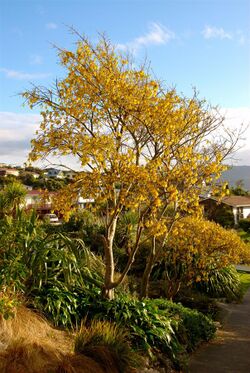Biology:Sophora microphylla
| Sophora microphylla | |
|---|---|

| |
| Tree in full bloom | |
| Scientific classification | |
| Kingdom: | Plantae |
| Clade: | Tracheophytes |
| Clade: | Angiosperms |
| Clade: | Eudicots |
| Clade: | Rosids |
| Order: | Fabales |
| Family: | Fabaceae |
| Subfamily: | Faboideae |
| Genus: | Sophora |
| Species: | S. microphylla
|
| Binomial name | |
| Sophora microphylla Aiton
| |
Sophora microphylla, commonly known as weeping kōwhai and small-leaved kōwhai, is a species of flowering tree in the family Fabaceae native to New Zealand. It is the most widespread of the eight species of kōwhai (the New Zealand Sophora). It is also called South Island kōwhai, although this name is misleading as it is widely distributed throughout the main islands of the country.
Growing to 8 m (26 ft) tall and broad, it is an evergreen shrub or small tree. Each leaf is 10 cm (4 in) long with up to 40 pairs of shiny oval leaflets. It produces many racemes of pea-like yellow flowers[1] from August or as early as May through to October.[2] The specific epithet microphylla means "small-leaved".[3] The plant has smaller leaflets (around 3–6 mm long by 2–5 mm wide) and flowers (1.8-5.0 cm long)[2] than the other well known species, Sophora tetraptera (large-leaved kōwhai). When young S. microphylla has a divaricating and bushy growth habit with many interlacing branches, which begins to disappear as the tree ages.[4]
It occurs throughout the main islands of New Zealand, though is scarce in parts of Northland and parts of the eastern North Island from East Cape south to northern Wairarapa.[2]
The cultivar Sun King 'Hilsop' has gained the Royal Horticultural Society's Award of Garden Merit.[5][6]
Its nectar is toxic to the honeybee.[7]
Pre-human forests
Studies of accumulated dried vegetation in the pre-human mid-late Holocene period suggests a low Sophora microphylla forest ecosystem in Central Otago that was used and perhaps maintained by giant moa birds, for both nesting material and food. Neither the forests nor moa existed when European settlers came to the area in the 1850s.[8]
References
- ↑ RHS A-Z encyclopedia of garden plants. United Kingdom: Dorling Kindersley. 2008. pp. 1136. ISBN 978-1405332965.
- ↑ 2.0 2.1 2.2 de Lange, P. J.. "Sophora microphylla". New Zealand Plant Conservation Network. https://www.nzpcn.org.nz/flora/species/sophora-microphylla/. Retrieved 17 October 2023.
- ↑ Harrison, Lorraine (2012). RHS Latin for gardeners. United Kingdom: Mitchell Beazley. pp. 224. ISBN 9781845337315.
- ↑ "Facts about kōwhai". Department of Conservation. http://www.doc.govt.nz/conservation/native-plants/kowhai/facts/. Retrieved 10 May 2012.
- ↑ "RHS Plant Selector - Sophora microphylla 'Hilsop'". https://www.rhs.org.uk/plants/332389/sophora-microphylla-sun-king/details. Retrieved 6 February 2022.
- ↑ "AGM Plants - Ornamental". Royal Horticultural Society. July 2017. p. 98. https://www.rhs.org.uk/plants/pdfs/agm-lists/agm-ornamentals.pdf. Retrieved 12 November 2018.
- ↑ Manson, Jessamyn; Rasmann, Sergio (2012). "Cardenolides in nectar may be more than a consequence of allocation to other plant parts: a phylogenetic study of Asclepias". Functional Ecology 26 (5): 1100–1110. doi:10.1111/j.1365-2435.2012.02039.x.
- ↑ Pole, Mike (2021-12-31). "A vanished ecosystem: Sophora microphylla (Kōwhai) dominated forest recorded in mid-late Holocene rock shelters in Central Otago, New Zealand" (in English). Palaeontologia Electronica 25 (1): 1–41. doi:10.26879/1169. ISSN 1094-8074. https://palaeo-electronica.org/content/2022/3503-vanished-ecosystem.
Wikidata ☰ Q7563131 entry
 |




